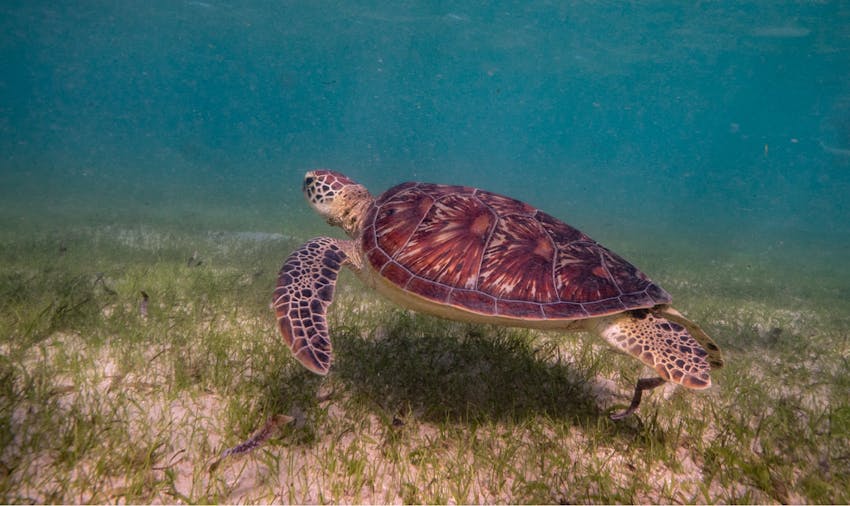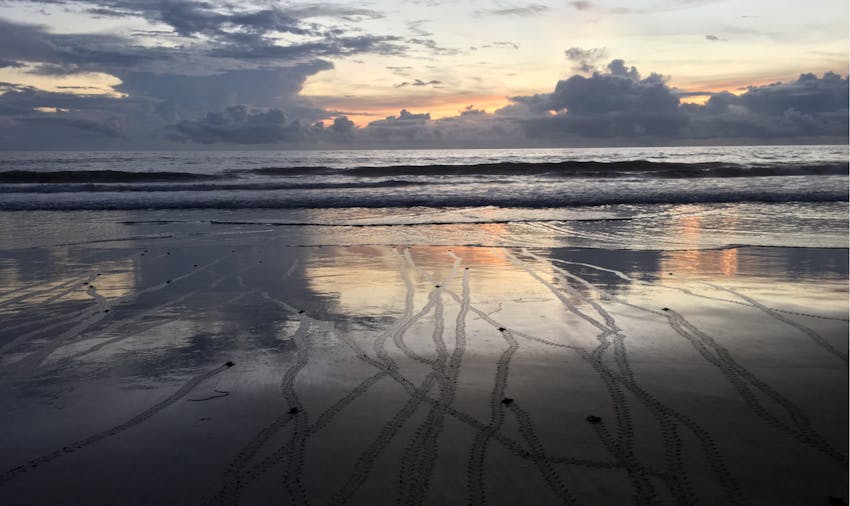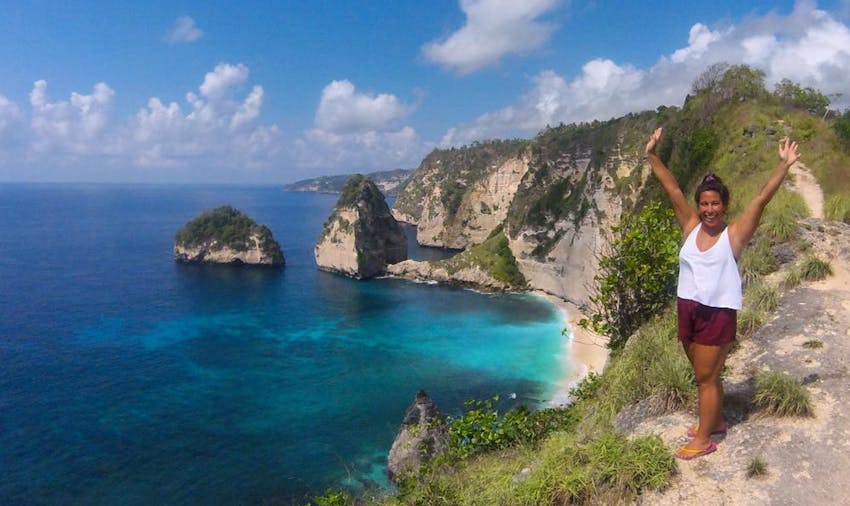
Are you looking for meaningful sea turtle conservation volunteer work? International Volunteer HQ offers sea turtle volunteer programs that support international conservation efforts in Costa Rica, Guatemala, Bali and Sri Lanka. With rising ocean pollution, habitat destruction, commercial fishing practices and illegal trade, endangered sea turtle species are becoming increasingly threatened.
If you are passionate about supporting the protection of sea turtles, eager to learn, and willing to work hard, take a volunteer trip and join like-minded travelers on one of our sea turtle volunteer programs. You will participate in a range of conservation-focused activities, including day and night time beach patrols, building hatcheries to keep turtle eggs away from predators, counting and tagging sea turtles, locating nesting females, working on projects to prevent excessive erosion of nesting habitats and working alongside local people in sustainable egg management.
Sea turtle volunteer vacations give you the opportunity to volunteer with sea turtles, help provide vital support to local staff and experts, while exploring a new culture and being immersed in the local community. IVHQ’s Turtle Conservation projects are perfect for volunteers with a passion for the marine environment, coastal living and warmer temperatures.
If this sounds like you, check out these three affordable sea turtle volunteer programs in Costa Rica, Guatemala, Bali and Sri Lanka.

Sea Turtle Conservation In Costa Rica
Sea turtle conservation volunteers in Costa Rica assist with studies of these species, protection work and sustainable egg protection programs. Volunteers live in one of four beach locations: Ostional, Drake Bay, Junquillal (based on the Pacific Coast) and Parismina (based on the Caribbean coast). There are four sea turtles species in Costa Rica - Leatherbacks, Greens, Olive Ridley and Hawksbill and the Costa Rica sea turtles hatching season changes depending on the location and sea turtle species. Therefore, the type of work you will be supporting will vary with location and time of year.
- Leatherbacks: On the Caribbean coast, they nest from March to July. On the Pacific, they nest from September to March.
- Greens: Nest from June to October along the North Caribbean, especially Tortuguero.
- Olive Ridleys: Along the Pacific, they nest throughout the year, though on many beaches the nesting is concentrated from July to November.
- Hawksbills: Nest in Cahuita National Park in September and October, and can be found foraging in the Golfo Dulce.
Volunteer work on this project is six days a week for 4 - 7 hours per day, in scheduled shifts (for example 10pm to 2am or 12am to 4am). A roster of these shifts ensures hours are equally distributed and is discussed with you once you arrive.
Activities involve patrolling (patrol duration depends on the amount of turtle activity that happens during that shift, but can take anywhere from two hours) and collecting data about population dynamics and hatching success. Beach patrols include tagging, measuring of turtles, checking for markings, counting the number of eggs being laid and taking weight measurements. Volunteers work under the supervision of local leaders and the project coordinator.

Costa Rica Turtle Conservation Volunteer Accommodation:
Accommodation on the Turtle Conservation project in Costa Rica is either in a volunteer house, or with a local family. You can expect to be accommodated on or near the beach. The accommodation is comfortable but basic, expect bunk beds/shared rooms/communal living and bathrooms.
When you are volunteering on the project, you will be provided with breakfast, lunch and dinner. You can expect typical Costa Rican dishes such as gallo pinto, plantain, tortillas, picadillos , fruit juice and coffee.
How To Spend Your Free Time In Costa Rica:
The project sites on the Caribbean and Pacific coasts are remote which means that paid tourism options are limited and best done from San Jose, either before or after your program. However, this gives you the opportunity to experience a unique insight into Costa Rican life while you are giving back on the project. Think authentic immersion, true Costa Rican coastal culture, beautiful sandy beaches and big blue, Pacific surf.
Volunteers typically spend their free time, hiking, snorkeling, relaxing on the beach, taking yoga classes, playing cards, reading, and surfing (depending on the location).
Costa Rica Turtle Conservation Project Specifics:
- You can choose to volunteer for 2-24 weeks
- Program fees from $610 for 2 weeks
- This project has an extra cost of £52 per week for supervision, materials and the logistics involved in the project. This amount will be included in the Program Fee quoted to you by IVHQ when you apply.
- Three meals per day are provided
- Volunteers can expect to work 6 days a week for 4 to 7 hours per day

Beach and Turtle Volunteer Programs In Guatemala
Guatemala is home to four out of the seven sea turtle species (Olive Ridley, Green turtles, Hawksbill and Leatherback). The Hawksbill and Leatherback are considered critically endangered due to poaching, the destruction of their natural habitat and commercial fishing. The Beach & Turtle Conservation project in Guatemala aims to help them flourish in their natural habitat which is important for the ecosystem and for long-term sustainability. Volunteers assist a government organisation on the Pacific Coast with beach conservation and seasonal sea turtle protection programs.
- February to June: Volunteers assist in habitat conservation efforts and planting mangroves, educational programs in local schools (some Spanish is required) and Teaching English to the local community.
- May to July: Volunteers help with the sick and injured turtles and improving the facilities. This includes painting the 3 hatcheries and getting them ready to take care of the collected eggs.
- July to October: This is typically nesting season
- September to December: This is typically hatching season, therefore those volunteering from July through to December will be involved with patrolling the beaches at night, turtle egg collection, observing nesting and releasing turtle hatchlings.
There are plenty of activities to be done on the project year-round, including beach and mangrove clean-up campaigns, construction or repair of park facilities and hatcheries, organising community projects and creating signs to put around the community to better educate the public and assisting the veterinarian on his monthly visit to check and monitor the adult turtles.
This project is perfect for volunteers that are not afraid to get stuck in and get their hands dirty. Keep in mind that while speaking Spanish is not a requirement, typically staff at the local placement speak limited English. The hostel manager is fluent in English and the field manager will visit and provide a cell phone to use to stay in touch.

Where You Will Be Located In Guatemala:
The Guatemala Turtle Conservation project is based on the Pacific coast of Guatemala, in a small beach-side community. When volunteering on this project, you should aim to arrive into La Aurora International Airport (GUA) in Guatemala City on the Sunday prior to your program start date.
You’ll spend your first night in the popular town of Antigua, which where the local team’s office is based and where your orientation is hosted. You’ll then make your way to the project location on Monday afternoon and a shuttle is provided to transport you to the project site, which takes approximately three hours. Volunteers return back to Antigua on the final Friday of your volunteer experience.
At the project, you will be accommodated in a dormitory-style room at a local hostel. The rooms are open-air and mosquito nets are provided. The hostel has WiFi access and there is a pool to relax in during your free time. Breakfast and dinner are provided as part of your program fee; however, you are free to arrange your own lunch. Breakfast is ordered off the menu and dinner is provided family-style, where you dine with the other guests outside in the courtyard area.
How To Spend Your Free Time In Guatemala:
Make sure you bring a book or some Spanish language study material to pass the time as you relax in a hammock by the pool, or in the ocean-view swing. You can also gather your volunteer fam and get a competition going on the official-size beach volleyball court at the volunteer accommodation. Regardless of how you choose to spend your free time, you’ll be able to make the most of the incredible coastline and explore the region.
Guatemala Turtle Conservation Project Specifics:
- You can choose to volunteer for 2-24 weeks
- Program fees from $535 for 2 weeks
- This project also has an extra cost of £52 per week for the extra supervision, materials and logistics involved. This amount will be included in the Program Fee quoted to you by IVHQ when you apply
- Breakfast and dinner are provided as part of your program fee
- Volunteers can expect to work six days a week, for around five hours per day

Turtle Conservation In Bali:
Volunteers on the Turtle Conservation project in Bali work alongside the local team at a turtle sanctuary, collecting vital baseline data on the turtle population in Nusa Penida. Depending on the time of year and whether or not it’s hatching season, you may be identifying turtle species, feeding and cleaning of turtles and the equipment at the centre, monitoring nests or watching baby sea turtle hatchlings find safe passage to the sea.
Volunteers engage in hands-on work with the turtles for one to two hours each day, which includes feeding and cleaning turtles, caring for turtles who are victims of commercial fishing and cleaning the turtle tanks. Additionally, volunteers are involved in beach clean-ups and the collection of live food for turtles.
The second half of the day focuses on proactive conservation efforts. These activities can include developing campaigns focused on turtle and environmental conservation, releasing turtles back into the wild, construction and maintenance of the turtle conservation center and collecting data on turtles held at the centre.

Where You Will Be Located In Bali:
For the first week of your program, you will participate in a 5-day orientation in Ubud. This gives you an authentic insight into the culture of Bali and allows you to get to know the local team and the other volunteers you will be working with. During this time, you are accommodated at the volunteer houses, which acts as a hub for volunteers and is an awesome way to cement your friendships with fellow volunteers.
On the Sunday after orientation week, you’ll be transported to Nusa Penida via speedboat, which takes approximately 45 minutes. Nusa Penida is an incredible island, which you can explore in your free time! Think breathtaking blue waters and vast cliffs. Living conditions on Nusa Penida are basic yet comfortable and volunteers can expect to share a room with one to seven other volunteers of the same gender.
How To Spend Your Free Time In Bali:
There’s plenty to fill in your free time on Nusa Penida. You can tick snorkeling with Manta Rays off your bucket list, or visit Crystal Bay, the best-known strip of sand on the island. Otherwise grab a photo at Kelingking beach lookout point, a spot that is quickly become a must-have Instagram photo. You can also check-out the arch at Pasih Uug Beach or head across the channel and explore Nusa Lembongan, a small island next to Nusa Penida.
Bali Turtle Conservation Project Specifics:
- You can choose to volunteer for 2-12 weeks
- Program fees from US $600 for 2 weeks
- For your first week of the program, you can participate in a 5-day orientation in Ubud
- Island location

Turtle Conservation in Sri Lanka:
As a Turtle Conservation volunteer in Sri Lanka, you’ll be helping injured turtles and contributing to conservation efforts in the Indian Ocean. The project focuses on caring for disabled turtles, enhancing conservation and encouraging recycling awareness among fishermen and the community, with an overall goal of increasing the local turtle population.
When you volunteer with turtles, you’ll be helping to clean the turtles and their tanks, sourcing and preparing the food, feeding the turtles, assisting with beach cleaning, maintaining hatcheries, relocating eggs to protect them from predators and releasing hatchlings. Your role will vary according to the time of the year, and it’s important to be flexible with regards to the tasks you are assigned.

Where You Will Be Located In Sri Lanka:
All volunteers take part in Introduction Week in Kandy from Monday to Friday, which gives you an authentic insight into the local culture. You will stay with others in the volunteer house and get the opportunity to explore the city.
You will then travel to the project site on Sunday, which is located around three hours away. The Turtle Conservation project is based in the southern coastal town of Ambalangoda, famous for its ancient masks and dancers.
Here you can expect to stay in a basic dormitory-style volunteer house, located a 5-minute walk away from the beach and the placements. You will have three meals provided for you per day.
How To Spend Your Free Time In Sri Lanka:
Ambalangoda is in the centre of the southern coastal area, with easy access to the breathtaking beaches and rivers with scenic views. The city is close to well-known historical cities such as Galle and Matara, and you can also explore the beauty of wider southern Sri Lanka in your weekends, which the local team can advise you on and help in making arrangements.

Nearby places to explore include:
- Galle Fort
- River Safari in Madugaga/ Visit to South Asia’s longest buddha statue in Ambalangoda
- Mask museum/Moonstone musume
- Hikkaduwa beach and corls and snorkeling
- Whale watching in Mirissa
- Yala/Udawalawa/Bundala national parks
- Unawatuna beach
- Visit to Sinharaja rainforest
Sri Lanka Turtle Conservation Project Specifics:
- You can choose between a 2-4 week duration
- All volunteers take part in Introduction Week in Kandy from Monday to Friday, before traveling to the project site on Sunday.
- Program fees from US$630 for 2 weeks
Whether you decide to volunteer in Costa Rica, Guatemala, Bali or Sri Lanka, you can set off knowing that by taking a sea turtle volunteer vacation, you are supporting international conservation efforts and travelling with meaning. For more information, see our full range of volunteer abroad programs.

